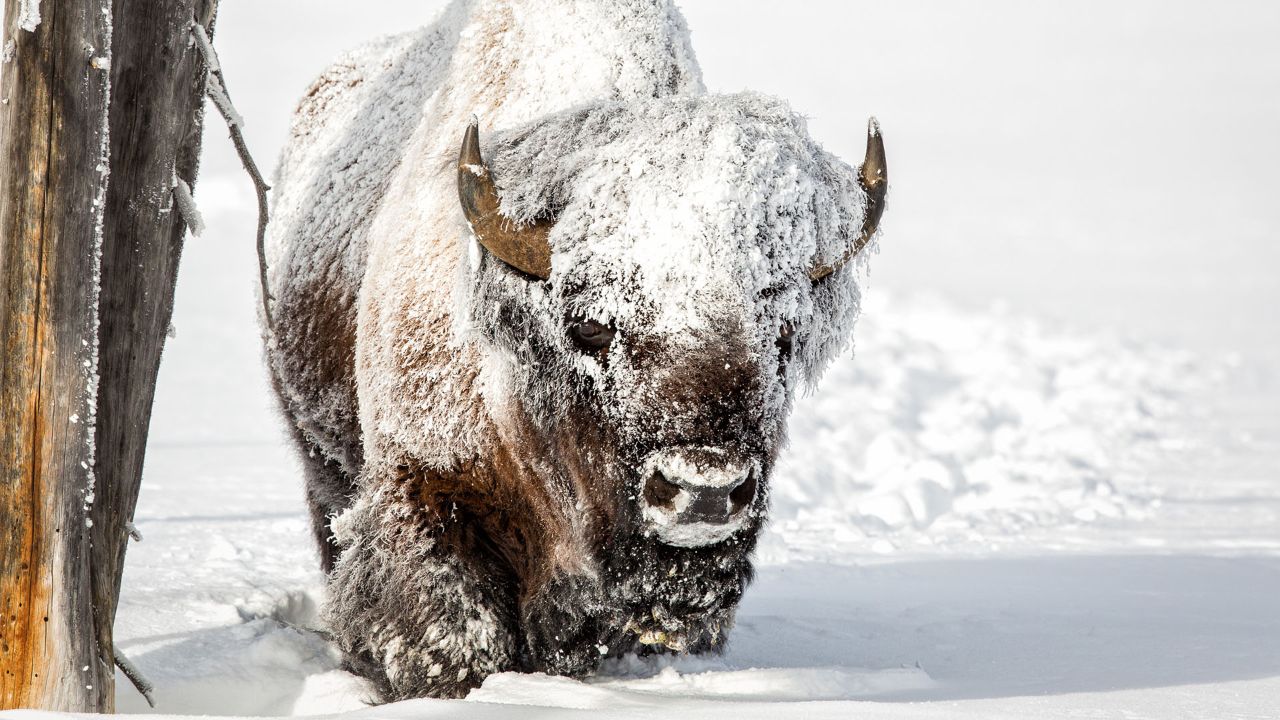Brave the Elements and Enjoy the Beauty of Yellowstone in Winter

Story and photos by Derek Jerrell
Derek is an award-winning freelance photographer specializing in landscape, wildlife and outdoor adventure photography.
During the cold-weather months, the park offers spectacular scenes of wildlife.
With a fresh blanket of snow on the ground and falling temperatures, winter has officially arrived at Yellowstone National Park.
The world’s first national park is also one of the coldest. In winter, temperatures top out in the teens, and can plummet to 20 degrees below zero. With an average elevation of 8,000 feet, Yellowstone can be affected by alpine weather systems that produce bone-chilling temperatures and an average of 150 inches of snow a year.
As temperatures drop, so does the number of park visitors. Summer months see peak traffic around 900,000 people a month while winter months can have as few as 20,000.
Traveling by Snowmobile
Off-peak travel can yield fantastic benefits. In addition to fewer tourists and less congestion in the park, locals are more accommodating and willing to engage in conversation. This interaction provides an opportunity to learn about lesser-known locations and local wildlife sightings. During the cold-weather season, herds of wildlife migrate down from higher elevations in search of food and warmth with wolf, coyote, elk and bison replacing the summer visitors.
For several years, I have dreamed about navigating Yellowstone’s harsh terrain to photograph wildlife in winter. From the moment I first discovered photography, I enjoyed the challenge of capturing wildlife in their natural habitat. To capture unique photographs takes time. You have to learn the animals’ habits and mannerisms and anticipate their actions. I find it exhilarating to be alone and outnumbered by the wild species that live in the park, but to fulfill my dream, I had to deal with some logistical challenges. Only one park road remains open during winter, and accessing inner regions of the park requires cold-weather equipment.
When I arrived at Yellowstone, I decided to travel the park by snowmobile. After all, I was here to capture photographs of wildlife in their natural habitat, and that would be hard to do from inside a tour bus. I needed to be able to travel light and react quickly. If an opportunity presented itself, I wanted to be prepared.
At 5:30 a.m. I found myself walking through the cold, dark parking lot of Three Bear Snowmobile Tours in West Yellowstone, Montana. It was 14 degrees below zero. Although tours would not typically begin for another couple of hours, my guide, Chris Daniels, had made arrangements to get me into the park well before sunrise. Daniels has been guiding snowmobile tours in Yellowstone for over 10 years and knows the park well. If anyone was going to help me get the shots I wanted, Daniels was the guy to do it.
After a quick cup of coffee, we both hopped on our snowmobiles and started the ride toward Yellowstone. I could see the dim lights of Three Bear fading in the rearview mirror. Even though we got an early start, we still had to hustle to the northwest area of the park if we were going to make it to our first stop in time to catch the sun rising over the mountains.
As we were getting our cameras set up, I could tell the day was going to be special. We were standing in deep snow on the banks of the Madison River, watching it wind its way through the landscape, around the bison and into the mountains where the sun had begun to light up the sky. With our first shots under our belts, we headed south, deep into the park in search of our next location, Tangled Creek.
The Silence of Tangled Creek
I have been to Tangled Creek several times during the summer, but experiencing it in winter is a photographer’s dream. The cold air and warm water created a blanket of fog that hovered throughout the trees giving the area a bit of an eerie feeling. No crowds or noisy cars were around.
As we left Tangled Creek, the weather began to turn. Clouds rolled in, flakes began to fall, and we were excited at the thought of capturing wildlife in fresh snow. We came across a small herd of bison huddled around the warmth of some geothermal water. As they clustered together, they quickly become covered in frost. The combination of the snow and frost was exactly the shot we were seeking. The conditions were fierce, but for us, it was worth it.
As the day began to wind down, we made our way back to West Yellowstone and back to Three Bear Snowmobile Tours parking lot where we began our adventure almost 12 hours earlier. We wrapped up with a cold drink and mouth-watering burger — reliving the excitement of the day. We had endured the elements and caught a glimpse of what makes winter in Yellowstone so amazing.
Around each bend a new landscape unfolds, new wildlife emerges and new opportunities present themselves. For those who are willing to brave the harsh conditions of winter in Yellowstone, the rewards can be rich and plentiful.
Road Trip to Witness the Bald Eagle Migration
More of the birds spend winter in Illinois than in any state outside Alaska.
Road Trip to Maple Sugar Shacks in New England
From New Orleans to the Northeast, one foodie sets out to explore the sweet beyond.
Road Trip to Montana’s Independently Owned Ski Areas
Mom-and-pop lodges offer affordability and community.
Visiting Glacier National Park in Winter
Montana’s gem offers different rewards during the season of stillness.
Winter Wonderlands: 7 Road Trips in Our National Parks
From A (Acadia) to Z (Zion), national parks offer ideal destinations for a weekend trip or longer vacation.
9 Epic Winter Road Trip Destinations to Escape the Cold
A winter road trip in an Enterprise rental car takes you to Florida, Texas, Arizona, California and all around the island of Maui in Hawaii. Heat up your sense of adventure and escape from the cold!
Four Can’t-Miss Winter Destinations
Try snowboarding, dogsledding, biking or a scenic drive in one of these memorable locales.
Swimming With Manatees in Florida
A close encounter with these gentle giants makes for an unforgettable adventure.
Yellowstone National Park in Winter
During the cold-weather months, the park offers spectacular scenes of wildlife.
Mountain Musings in Lincoln, New Hampshire
Generations Connect on the Ski Slopes of the White Mountains.
Gear up for Ski Season in the White Mountains
Lincoln, New Hampshire, features great lodges and shops.
Snowshoeing in Rocky Mountain National Park
The Love family embraces winter in Colorado to experience a new adventure.

Start A Reservation
Enjoy fast and easy car rental bookings from Enterprise Rent-A-Car at one of our 7,200 branches in cities, airports and neighborhoods near you.
Reserve Now
Email Offers
Don't miss an excuse to hit the road: our latest offers delivered to your inbox.
Sign Up





